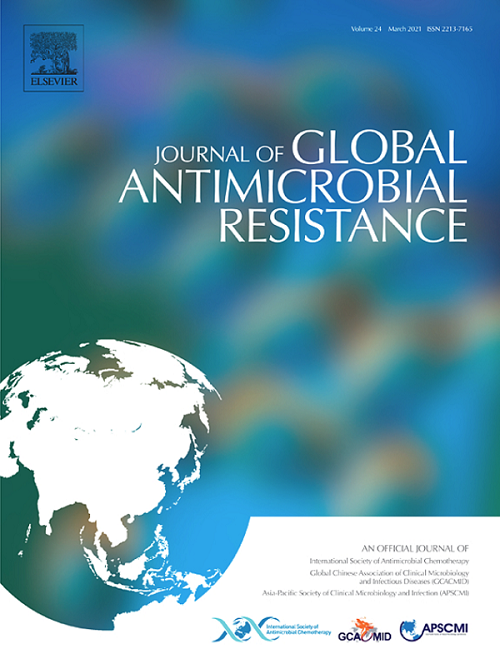中国临床亚胺培南非敏感肺炎克雷伯菌分离株:流行病学、分子特征及亚胺培南/瑞巴坦体外活性
IF 3.2
3区 医学
Q2 INFECTIOUS DISEASES
引用次数: 0
摘要
目的:了解亚胺培南/瑞巴坦对亚胺培南不敏感(IPMNS)肺炎克雷伯菌的流行病学、分子特征及体外活性。方法:2019年在全国5个地区16个地点采集肺炎克雷伯菌分离株。进行药敏试验。IPMNS肺炎克雷伯菌分离株采用全基因组测序筛选耐药和毒力基因。结果:1011株临床分离肺炎克雷伯菌中,IPMNS患者277株(27.3%),ICU患者多见(47.5%),医院获得性感染多见(28.9%)。产碳青霉烯酶是主要的耐药机制,228株(89.8%)IPMNS菌株携带blaKPC-2、8株(3.1%)blaNDM、2株(0.7%)blaOXA-232和1株(0.4%)blaOXA-181。优势克隆为st11型(78.7%),其次为ST15型(10.2%)。乐巴坦在96.3%携带blaKPC-2基因的分离株中恢复了亚胺培南的敏感性。结论:携带blaKPC-2基因是中国IPMNS肺炎克雷伯菌的主要机制。当没有易感性或碳青霉烯酶试验时,可考虑经验性亚胺培南/瑞巴坦治疗。本文章由计算机程序翻译,如有差异,请以英文原文为准。
Clinical imipenem non-susceptible Klebsiella pneumoniae isolates from China: Epidemiology, molecular characterization and in vitro activity of imipenem/relebactam
Objective
To describe the epidemiological and molecular characterization and in vitro activity of imipenem/relebactam against imipenem non-susceptible (IPMNS) Klebsiella pneumoniae isolates in China.
Methods
K. pneumoniae isolates were collected from 16 sites in 5 regions across China during 2019. Antimicrobial susceptibility testing was performed. For IPMNS K. pneumoniae isolates, whole genome sequencing was used to screen for drug-resistance and virulence genes.
Results
Of 1011 clinical K. pneumoniae isolates, 277 (27.3%) were IPMNS and were significantly more common in intensive care unit patients (47.5%) and hospital-acquired infections (28.9%). Production of carbapenemase was the dominant resistance mechanism, with 228 (89.8%) IPMNS isolates harbouring blaKPC-2, 8 (3.1%) blaNDM, 2 (0.8%) blaOXA-232 and 1 (0.4%) blaOXA-181. The dominant clone was sequence type (ST) 11 (78.7%) followed by ST15 (10.2%). Relebactam restored imipenem’s susceptibility in 96.5% isolates harbouring a blaKPC-2 gene.
Conclusions
Harbouring the blaKPC-2 gene was the dominant mechanism of IPMNS K. pneumoniae in China. Empirical imipenem/relebactam treatment could be considered when susceptibility or carbapenemase tests are not available.
求助全文
通过发布文献求助,成功后即可免费获取论文全文。
去求助
来源期刊

Journal of global antimicrobial resistance
INFECTIOUS DISEASES-PHARMACOLOGY & PHARMACY
CiteScore
8.70
自引率
2.20%
发文量
285
审稿时长
34 weeks
期刊介绍:
The Journal of Global Antimicrobial Resistance (JGAR) is a quarterly online journal run by an international Editorial Board that focuses on the global spread of antibiotic-resistant microbes.
JGAR is a dedicated journal for all professionals working in research, health care, the environment and animal infection control, aiming to track the resistance threat worldwide and provides a single voice devoted to antimicrobial resistance (AMR).
Featuring peer-reviewed and up to date research articles, reviews, short notes and hot topics JGAR covers the key topics related to antibacterial, antiviral, antifungal and antiparasitic resistance.
 求助内容:
求助内容: 应助结果提醒方式:
应助结果提醒方式:


